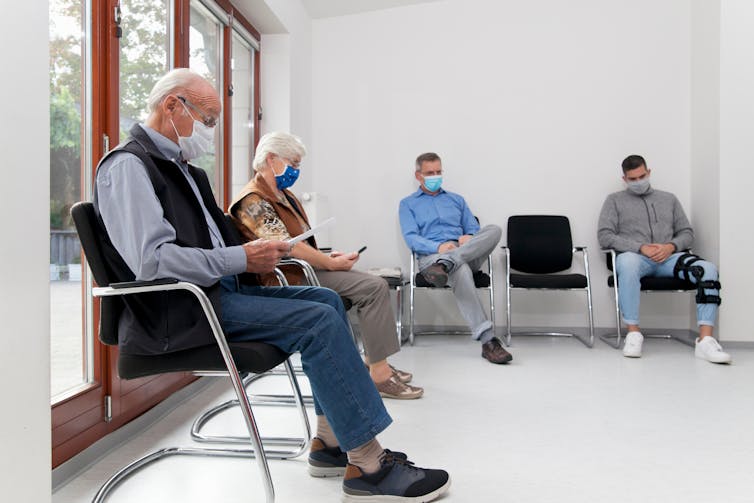
Perhaps you have been happily attending the same GP for many years. They know your medical history better than anyone. Then all of a sudden they retire, or the practice closes, or it gets taken over by a bigger company and everything at the practice changes. Or maybe you’ve just had an unexpected visit to hospital and they ask who your GP is on discharge, then you realise you’re in need of one.
More than 80% of Australians visit a GP each year and those with chronic medical conditions will attend multiple times within the same period. It’s important to have a good GP who can coordinate your care. So how do you find a new one to develop a trusted relationship with?
As practising GPs ourselves, we are often asked: “Do you know a good GP?” This can be a somewhat difficult question to answer, as each person’s perception of “good” is highly subjective, dependent on many factors.
Studies of peoples’ preferences have varied results. One study found the listening ability of the GP to be important. Other studies found patients put more value in clinical competency, a trusting relationship or continuity of care.
So a better question is: what GP will be a good fit for me?
Read more: GPs are abandoning bulk billing. What does this mean for affordable family medical care?
What factors are important to you? 6 aspects to consider
Here are some tips to help speed up your search for your new GP. Remember though, it may take a few visits to develop a trusting relationship and know if the fit is right for you.
1. Your health needs
If you are young and healthy, a GP offering a convenient service and who is easy to book in quickly with may suffice. For those living with chronic complex conditions or disabilities who need to visit often, a consistent and thorough doctor is recommended.
2. Cost
Bulk-billing doctors are becoming rarer given the rising cost of services, salaries, equipment and utilities. To stay afloat, these doctors are having to see more patients in less time.
This could result in a poorer understanding of you as an individual and your health values and goals. Again, this might not be a problem for simple consults. But if you get a serious disease down the track, you might wish you’d had a regular GP all along, because they would know you and your history.
If you’re able to wear some extra cost but wondering how much to pay, consider the Australian Medical Association recommendation as your guide – a standard 15-minute consult cost is $86 with a $39 rebate from Medicare.
3. Accessibility and practice size
Consider the distance you need to travel and the opening hours you may need, including weekend availability.
Bigger practices are more likely to be able to get you in to see a doctor, if not your doctor, and often have longer opening hours. Having more than one preferred GP within the same practice can provide more flexibility and they will each be able to access your medical records and results. You may want to enquire also about disability access and telehealth options.

4. Reviews
Online recommendations can be tricky to interpret. Only 6–8% of people post online reviews for doctors. And there are plenty of people out there who have inappropriate requests or expectations of GPs, which may be their basis for a negative review. Also, someone who has been happily seeing their GP for decades is less likely to post a rating than a one-off visitor.
Be sure to consider what reasons were given for a negative review – was it because of actions taken, an attitude, or a personality clash? – and how those reasons align with your preferences. In saying that, community Facebook groups are often a hotspot for discussions about local GPs and recurrent positive recommendations can and should be held in higher regard.
5. New doctors
There are many young GPs starting off in the profession or new to the area. Many will be fantastically caring and competent. But these doctors are not going to come with recommendations yet.
These GPs often have plenty of appointment slots, and the most recent up-to-date training. Being an early adopter of their services could be to your benefit.
Read more: How do you fix general practice? More GPs won't be enough. Here's what to do
6. Sub-specialists
Many GPs have special interests and advanced skills, such as skin cancer care, musculoskeletal medicine, women’s health or mental health.
They may have done postgraduate training, usually listed on the practice website along with their special interests. They are likely to have a shorter waiting time and lower costs than specialists – so consider these doctors if your needs match their expertise.
Other things to check
About 80% of practices go through a practice accreditation process, which proves attainment of standards set by the Royal Australian College of General Practitioners. Such practices will advertise this status on their website and at the entrance to the clinic.
You can also ask about a doctor’s qualifications and about the standard consultation length. This may range from 10 to 20 minutes. Don’t be afraid to ask these questions when calling a practice about your first visit.
The final and arguably most important test is how you connect when you meet them in person. Finding a GP can be like finding your favourite cardigan. You don’t know it’s your favourite until it has been worn in.
Similarly you don’t know that your GP is great until you’ve journeyed with them through some potentially challenging times of your life. We encourage you to use the above tips to find a suitable GP, then give them some time to get to know you and grow a therapeutic relationship.
With continuity of care, trust will grow, as will knowledge about you and your values. This will ultimately improve your overall health care experience.
Read more: General practices are struggling. Here are 5 lessons from overseas to reform the funding system
The authors do not work for, consult, own shares in or receive funding from any company or organisation that would benefit from this article, and have disclosed no relevant affiliations beyond their academic appointment.
This article was originally published on The Conversation. Read the original article.







